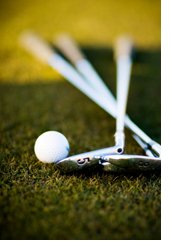Would You Play Better With Low Compression Golf Balls?
Have you ever heard the term "low compression golf balls?" Do you know what they are and what type of golfer should use them? Do you know which particular ball compression is best for you, personally?
Many golfers don't. If you're one of them, here is some basic information about this type of golf balls that can help you identify whether they're the right type of ball for you.
All golf balls are not created equal. Compression is just one of the ways golf balls can differ, but it can significantly impact your game because different ball compressions suit different types of golfers. Playing balls with the compression characteristics that match your swing can lower your scores and raise your enjoyment of the game.
In some ways, "compression" is another way of describing the hardness or softness of a ball. At the moment your club face impacts the ball, the ball deforms (compresses) and kinetic energy is transferred from the club to the ball. The deformed (compressed) ball rebounds to its original shape as it's launched into the air. The greater the deformation, the greater the rebound and the faster the ball will travel. High compression, harder balls deform more "reluctantly" at impact than low compression balls. As a general rule, the higher the compression rating of the ball, the faster your swing speed must be to cause the ball to deform as it should. Unless the ball deforms (compresses) optimally, you'll never achieve the maximum potential energy transfer from club head to ball.

Many amateurs are unable to swing fast enough to compress the ball optimally when they're playing a high compression ball. These types of balls simply require more force to compress the way they're intended to.
You
can lose significant distance by playing a ball with a compression rate
that's too high for your swing speed. Despite this risk, many amateurs
are tempted to play with higher-compression balls than they actually
should. There are main two reasons that golfers succumb to this
temptation:
- Some men think it's "macho" to play high compression balls, even though low compression golf balls might be more appropriate for their swing; and
- If a player does happen to have the swing speed required by high compression balls, that player's shots will tend to travel farther than they would if the same person used a low compression version. Hope springs eternal among golfers, and most of us think we have faster swing speeds than we actually do. Many players with slower swings incorrectly think they're capable of hitting high compression balls, so that's what they use.
Low compression golf balls are much softer and easier to compress than high compression balls. As a result, they are much more suited to golfers with slow swings than their high compression counterparts. The soft cores of these balls deform much more readily with slow swings than the harder cores of high compression balls. More energy is transferred at impact and the ball travels farther.
Balls have compression ratings. In the old days, high compression balls were rated "100", intermediate at "90" and low were usually around "80." Now, however, golf ball companies are recognizing that low compression can help players with slower swings, and they're making balls with increasingly lower compression ratings. Golfers are also discovering the benefits of these balls, and they're making them one of the fastest-growing segments of the golf ball market.
In addition to helping golfers with slower swings maximize their distance, low compression golf balls provide a softer feel when you're playing in cool weather. When it's cold, high compression balls can feel like rocks at impact. In contrast, low compression golf balls retain more of their softer feel and can be much less jarring to your hands on mishits.
Here's the bottom line on low compression golf balls and whether they can your game: if you're just starting to play golf, you have a swing speed that's on the slow side, or you're a mid- to high-handicap player, you'll almost certainly be better off playing low compression golf balls. If, on the other hand, you're a low-handicap golfer or have an extremely fast, tour-caliber swing, high compression balls could be the better choice. Match the compression of your balls to your swing speed.
Some popular choices in low compression golf balls include the Precept Lady, the Precept Laddie, the Titleist DT SoLo and the TaylorMade/Maxfli Noodle, but there are many others.
From low compression golf balls to golf ball reviews.



New! Comments
Have your say about what you just read! Leave us a comment in the box below.